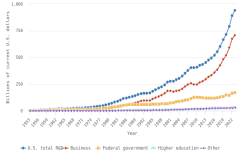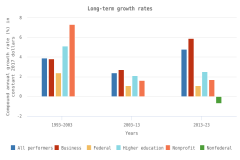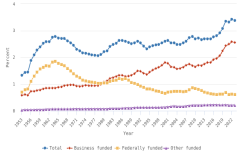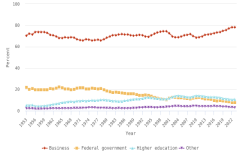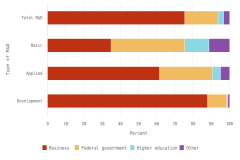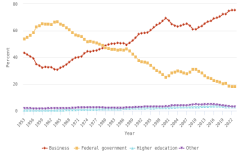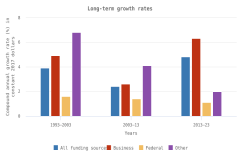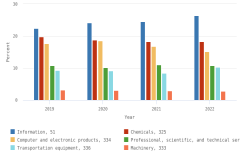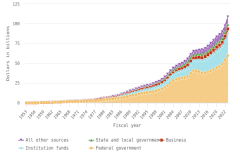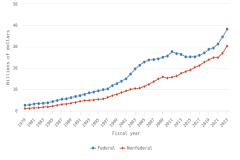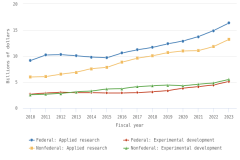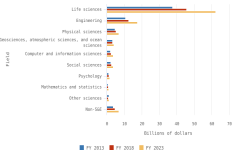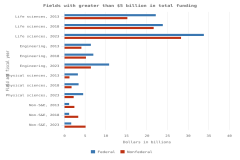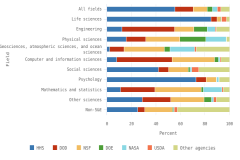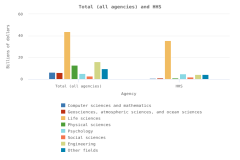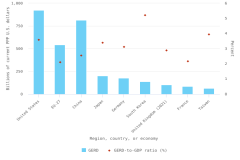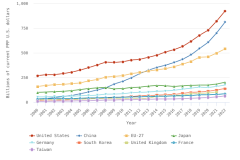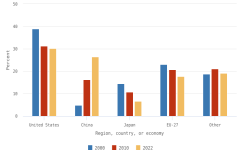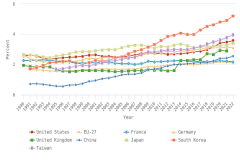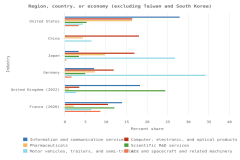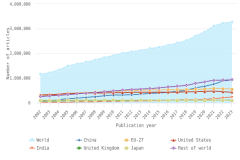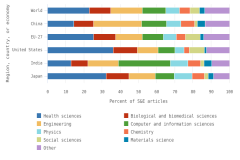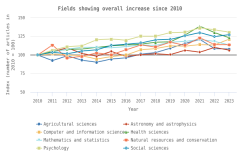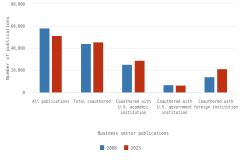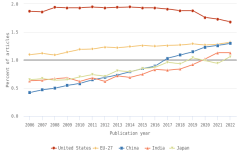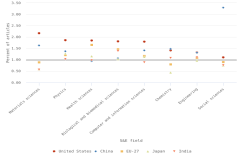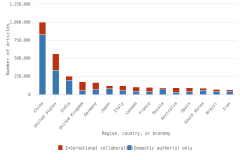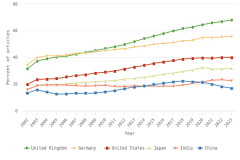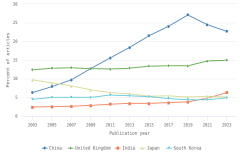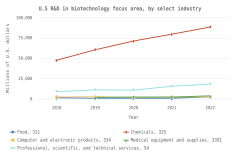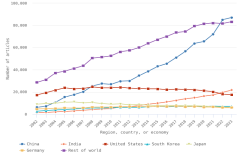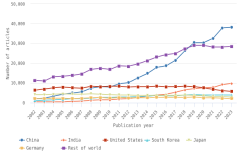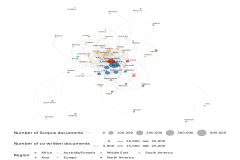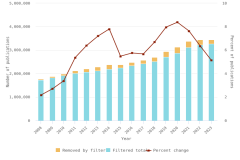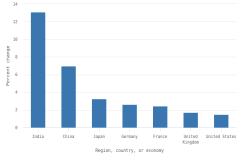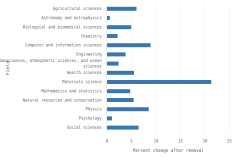Trends in U.S. R&D Performance and Funding
R&D activity presented in this report is measured as R&D performance and R&D funding. Performance of R&D focuses on the organization or sector that conducts R&D activities, which may be funded from a variety of internal and external sources. R&D funding refers to financial resources that may be devoted to internal R&D or to pay for R&D performed by other organizations or sectors. R&D-performing and R&D-funding sectors include businesses, governments, higher education institutions, and nonprofit organizations (OECD 2015).
As detailed further below, the business sector is by far the largest U.S. R&D-performing and R&D-funding sector; the federal government is the second-largest funding source. Higher education R&D performance has grown slowly, but steadily, in recent years, whereas R&D performance by the federal government has declined slightly since 2021 when adjusted for inflation.
U.S. Total R&D and R&D Intensity
Recent growth in overall U.S. R&D performance is consistent with historical growth rates and is driven by the rapid growth of R&D performed by the business sector. The United States performed $891.8 billion in 2022 and an estimated $939.6 billion in 2023 in current U.S. dollars (Figure DISC-1, Figure DISC-2; Table DISC-1) (NCSES 2025d). This is an increase of 5% from 2022 (2% in constant [inflation-adjusted] 2017 U.S. dollars). Since 1953, U.S. R&D performance has increased annually at a 3% compound annual growth rate (CAGR) in constant dollars (NCSES 2025d: Table 1). For the past three decades, the CAGR for total U.S. R&D expenditures has fluctuated between 2% and 5%, driven largely by business sector performance (Figure DISC-3). From 2013 to 2023, business R&D performance grew at an annual CAGR of 6% in constant dollars, the highest sectoral growth rate over this period.
| Year | U.S. total R&D | Business | Federal government | Nonfederal government | Higher education | Nonprofit organizations |
|---|---|---|---|---|---|---|
| 1953 | 5.2 | 3.6 | 1.1 | NA | 0.3 | 0.1 |
| 1954 | 5.6 | 4.1 | 1.1 | NA | 0.3 | 0.1 |
| 1955 | 6.2 | 4.4 | 1.3 | NA | 0.3 | 0.1 |
| 1956 | 8.5 | 6.3 | 1.7 | NA | 0.4 | 0.1 |
| 1957 | 9.9 | 7.3 | 2.0 | NA | 0.4 | 0.2 |
| 1958 | 10.9 | 8.1 | 2.2 | NA | 0.5 | 0.2 |
| 1959 | 12.5 | 9.2 | 2.5 | NA | 0.6 | 0.2 |
| 1960 | 13.7 | 10.0 | 2.7 | NA | 0.7 | 0.3 |
| 1961 | 14.6 | 10.4 | 3.1 | NA | 0.8 | 0.3 |
| 1962 | 15.6 | 11.0 | 3.2 | NA | 1.0 | 0.4 |
| 1963 | 17.5 | 12.2 | 3.7 | NA | 1.2 | 0.4 |
| 1964 | 19.1 | 13.0 | 4.3 | NA | 1.4 | 0.4 |
| 1965 | 20.3 | 13.8 | 4.4 | NA | 1.6 | 0.5 |
| 1966 | 22.1 | 15.2 | 4.5 | NA | 1.8 | 0.5 |
| 1967 | 23.3 | 16.0 | 4.8 | NA | 2.0 | 0.6 |
| 1968 | 24.7 | 17.0 | 4.9 | NA | 2.2 | 0.6 |
| 1969 | 26.0 | 17.8 | 5.2 | NA | 2.3 | 0.6 |
| 1970 | 26.3 | 17.6 | 5.6 | NA | 2.4 | 0.7 |
| 1971 | 27.0 | 17.8 | 5.8 | NA | 2.6 | 0.7 |
| 1972 | 28.7 | 19.0 | 6.2 | NA | 2.8 | 0.8 |
| 1973 | 31.0 | 20.7 | 6.4 | NA | 3.0 | 0.9 |
| 1974 | 33.4 | 22.2 | 6.9 | NA | 3.2 | 1.0 |
| 1975 | 35.7 | 23.5 | 7.6 | NA | 3.6 | 1.1 |
| 1976 | 39.4 | 26.1 | 8.3 | NA | 3.9 | 1.1 |
| 1977 | 43.3 | 28.9 | 8.9 | NA | 4.3 | 1.2 |
| 1978 | 48.7 | 32.2 | 10.1 | NA | 5.0 | 1.4 |
| 1979 | 55.4 | 37.1 | 11.0 | NA | 5.7 | 1.6 |
| 1980 | 63.2 | 43.2 | 11.9 | NA | 6.5 | 1.7 |
| 1981 | 72.3 | 50.4 | 13.0 | NA | 7.1 | 1.8 |
| 1982 | 80.7 | 57.2 | 14.1 | NA | 7.6 | 1.9 |
| 1983 | 89.9 | 63.7 | 15.8 | NA | 8.3 | 2.2 |
| 1984 | 102.2 | 73.1 | 17.5 | NA | 9.2 | 2.5 |
| 1985 | 114.7 | 82.4 | 19.2 | NA | 10.3 | 2.8 |
| 1986 | 120.2 | 85.9 | 19.9 | NA | 11.5 | 2.9 |
| 1987 | 126.4 | 90.2 | 20.4 | NA | 12.8 | 3.0 |
| 1988 | 133.9 | 94.9 | 21.6 | NA | 14.2 | 3.2 |
| 1989 | 141.9 | 99.9 | 22.7 | NA | 15.6 | 3.7 |
| 1990 | 152.0 | 107.4 | 23.5 | NA | 16.9 | 4.1 |
| 1991 | 160.9 | 114.7 | 23.3 | NA | 18.2 | 4.7 |
| 1992 | 165.4 | 116.8 | 24.2 | NA | 19.4 | 5.0 |
| 1993 | 165.7 | 115.4 | 24.5 | NA | 20.5 | 5.3 |
| 1994 | 169.2 | 117.4 | 24.6 | NA | 21.6 | 5.6 |
| 1995 | 183.6 | 129.8 | 25.4 | NA | 22.6 | 5.8 |
| 1996 | 197.3 | 142.4 | 25.0 | NA | 23.7 | 6.2 |
| 1997 | 211.9 | 155.4 | 25.2 | NA | 24.6 | 6.6 |
| 1998 | 225.8 | 167.1 | 25.8 | NA | 25.6 | 7.2 |
| 1999 | 244.5 | 182.1 | 26.8 | NA | 27.5 | 8.0 |
| 2000 | 267.9 | 200.0 | 28.5 | NA | 29.9 | 9.6 |
| 2001 | 278.5 | 202.0 | 32.8 | NA | 32.7 | 11.0 |
| 2002 | 277.9 | 193.9 | 35.5 | NA | 36.7 | 11.9 |
| 2003 | 291.4 | 200.7 | 37.2 | NA | 40.6 | 12.8 |
| 2004 | 302.7 | 208.3 | 37.7 | NA | 43.3 | 13.4 |
| 2005 | 325.3 | 226.2 | 39.6 | NA | 45.5 | 14.1 |
| 2006 | 350.9 | 247.7 | 41.6 | 0.3 | 47.4 | 14.0 |
| 2007 | 377.9 | 269.3 | 44.1 | 0.4 | 49.4 | 14.7 |
| 2008 | 404.8 | 290.7 | 45.6 | 0.5 | 52.1 | 15.9 |
| 2009 | 402.9 | 282.4 | 47.6 | 0.6 | 54.9 | 17.5 |
| 2010 | 406.6 | 279.0 | 50.8 | 0.7 | 58.1 | 18.0 |
| 2011 | 426.2 | 294.1 | 53.5 | 0.7 | 60.1 | 17.8 |
| 2012 | 433.7 | 302.3 | 52.1 | 0.7 | 60.9 | 17.8 |
| 2013 | 454.2 | 322.5 | 51.1 | 0.6 | 61.5 | 18.5 |
| 2014 | 475.9 | 340.7 | 52.7 | 0.6 | 62.3 | 19.6 |
| 2015 | 494.5 | 355.8 | 52.8 | 0.6 | 64.6 | 20.6 |
| 2016 | 521.7 | 379.5 | 51.2 | 0.6 | 67.8 | 22.6 |
| 2017 | 553.5 | 405.8 | 52.6 | 0.6 | 71.1 | 23.4 |
| 2018 | 603.8 | 445.6 | 58.4 | 0.6 | 74.9 | 24.4 |
| 2019 | 665.3 | 498.2 | 62.8 | 0.7 | 78.1 | 25.5 |
| 2020 | 716.5 | 543.2 | 65.1 | 0.7 | 80.8 | 26.7 |
| 2021 | 788.7 | 608.6 | 66.7 | 0.7 | 85.7 | 27.0 |
| 2022 | 891.8 | 697.3 | 71.5 | 0.7 | 94.3 | 28.1 |
| 2023 | 939.6 | 735.0 | 73.6 | 0.7 | 102.0 | 28.2 |
Some data for 2022 are preliminary and may be revised later. The data for 2023 include estimates and are likely to be revised later. Federal performers of R&D include federal agencies and federally funded R&D centers. Nonfederal government R&D performance is that of state governments (data in this series were not available prior to 2006). For more information, see Table 2 and Table 6 of National Patterns of R&D Resources (2022–23 edition).
National Center for Science and Engineering Statistics, National Patterns of R&D Resources (2022–23 edition).
Science and Engineering Indicators
| Year | U.S. total R&D | Business | Federal government | Higher education | Other |
|---|---|---|---|---|---|
| 1953 | 5.2 | 2.2 | 2.8 | 0.0 | 0.1 |
| 1954 | 5.6 | 2.4 | 3.1 | 0.0 | 0.1 |
| 1955 | 6.2 | 2.5 | 3.5 | 0.0 | 0.1 |
| 1956 | 8.5 | 3.3 | 5.0 | 0.0 | 0.1 |
| 1957 | 9.9 | 3.5 | 6.2 | 0.1 | 0.2 |
| 1958 | 10.9 | 3.7 | 7.0 | 0.1 | 0.2 |
| 1959 | 12.5 | 4.1 | 8.2 | 0.1 | 0.2 |
| 1960 | 13.7 | 4.5 | 8.9 | 0.1 | 0.2 |
| 1961 | 14.6 | 4.8 | 9.5 | 0.1 | 0.2 |
| 1962 | 15.6 | 5.1 | 10.1 | 0.1 | 0.3 |
| 1963 | 17.5 | 5.5 | 11.6 | 0.1 | 0.3 |
| 1964 | 19.1 | 5.9 | 12.8 | 0.1 | 0.3 |
| 1965 | 20.3 | 6.5 | 13.2 | 0.1 | 0.4 |
| 1966 | 22.1 | 7.3 | 14.2 | 0.2 | 0.4 |
| 1967 | 23.3 | 8.1 | 14.6 | 0.2 | 0.4 |
| 1968 | 24.7 | 9.0 | 15.0 | 0.2 | 0.5 |
| 1969 | 26.0 | 10.0 | 15.2 | 0.2 | 0.5 |
| 1970 | 26.3 | 10.4 | 15.0 | 0.3 | 0.6 |
| 1971 | 27.0 | 10.8 | 15.2 | 0.3 | 0.6 |
| 1972 | 28.7 | 11.7 | 16.0 | 0.3 | 0.7 |
| 1973 | 31.0 | 13.3 | 16.6 | 0.3 | 0.7 |
| 1974 | 33.4 | 14.9 | 17.3 | 0.4 | 0.8 |
| 1975 | 35.7 | 15.8 | 18.5 | 0.4 | 0.9 |
| 1976 | 39.4 | 17.7 | 20.3 | 0.5 | 1.0 |
| 1977 | 43.3 | 19.6 | 22.1 | 0.6 | 1.1 |
| 1978 | 48.7 | 22.5 | 24.4 | 0.7 | 1.2 |
| 1979 | 55.4 | 26.1 | 27.2 | 0.8 | 1.3 |
| 1980 | 63.2 | 30.9 | 30.0 | 0.9 | 1.4 |
| 1981 | 72.3 | 35.9 | 33.7 | 1.1 | 1.5 |
| 1982 | 80.7 | 40.7 | 37.1 | 1.2 | 1.7 |
| 1983 | 89.9 | 45.3 | 41.5 | 1.4 | 1.9 |
| 1984 | 102.2 | 52.2 | 46.5 | 1.5 | 2.1 |
| 1985 | 114.7 | 58.0 | 52.6 | 1.7 | 2.3 |
| 1986 | 120.2 | 61.0 | 54.6 | 2.0 | 2.6 |
| 1987 | 126.4 | 62.6 | 58.6 | 2.3 | 2.9 |
| 1988 | 133.9 | 68.0 | 60.1 | 2.5 | 3.2 |
| 1989 | 141.9 | 75.0 | 60.5 | 2.9 | 3.6 |
| 1990 | 152.0 | 83.2 | 61.6 | 3.2 | 4.0 |
| 1991 | 160.9 | 92.3 | 60.8 | 3.5 | 4.3 |
| 1992 | 165.4 | 96.2 | 60.9 | 3.6 | 4.6 |
| 1993 | 165.7 | 96.5 | 60.5 | 3.7 | 4.9 |
| 1994 | 169.2 | 99.2 | 60.8 | 3.9 | 5.3 |
| 1995 | 183.6 | 110.9 | 63.0 | 4.1 | 5.7 |
| 1996 | 197.3 | 123.4 | 63.4 | 4.4 | 6.1 |
| 1997 | 211.9 | 136.2 | 64.4 | 4.9 | 6.5 |
| 1998 | 225.8 | 147.8 | 65.9 | 5.2 | 6.9 |
| 1999 | 244.5 | 164.5 | 66.8 | 5.7 | 7.4 |
| 2000 | 267.9 | 186.0 | 67.2 | 6.3 | 8.5 |
| 2001 | 278.5 | 188.4 | 73.8 | 6.9 | 9.5 |
| 2002 | 277.9 | 180.7 | 78.9 | 7.7 | 10.7 |
| 2003 | 291.4 | 186.2 | 85.1 | 8.3 | 11.8 |
| 2004 | 302.7 | 191.3 | 90.8 | 8.6 | 12.0 |
| 2005 | 325.3 | 207.8 | 95.4 | 9.4 | 12.7 |
| 2006 | 350.9 | 227.2 | 99.9 | 10.2 | 13.6 |
| 2007 | 377.9 | 246.8 | 105.1 | 10.9 | 15.0 |
| 2008 | 404.8 | 258.0 | 117.6 | 11.7 | 17.4 |
| 2009 | 402.9 | 246.6 | 125.8 | 12.1 | 18.5 |
| 2010 | 406.6 | 248.1 | 126.6 | 12.3 | 19.6 |
| 2011 | 426.2 | 266.4 | 127.0 | 13.1 | 19.7 |
| 2012 | 433.7 | 275.7 | 123.8 | 14.3 | 19.9 |
| 2013 | 454.2 | 297.2 | 120.1 | 15.3 | 21.6 |
| 2014 | 475.9 | 318.4 | 118.4 | 16.2 | 23.0 |
| 2015 | 494.5 | 333.2 | 119.5 | 17.3 | 24.4 |
| 2016 | 521.7 | 360.3 | 118.2 | 18.7 | 24.5 |
| 2017 | 553.5 | 386.5 | 122.4 | 19.9 | 24.7 |
| 2018 | 603.8 | 426.5 | 131.0 | 21.0 | 25.4 |
| 2019 | 665.3 | 482.2 | 135.6 | 21.9 | 25.5 |
| 2020 | 716.5 | 520.3 | 148.0 | 22.6 | 25.6 |
| 2021 | 788.7 | 590.9 | 147.3 | 23.8 | 26.7 |
| 2022 | 891.8 | 673.1 | 164.5 | 26.6 | 27.7 |
| 2023 | 939.6 | 709.2 | 172.3 | 29.0 | 29.0 |
Some data for 2022 are preliminary and may be revised later. The data for 2023 include estimates and are likely to be revised later. Federal performers of R&D include federal agencies and federally funded R&D centers. R&D funding listed as Other combines data from nonfederal government (state and local) and nonprofit organizations. For more information, see Table 2 and Table 6 of National Patterns of R&D Resources (2022–23 edition).
National Center for Science and Engineering Statistics, National Patterns of R&D Resources (2022–23 edition).
Science and Engineering Indicators
FFRDC = federally funded research and development center.
a Some data for 2022 are preliminary and may be revised later.
b The data for 2023 include estimates and are likely to be revised later.
c Federal intramural includes expenditures of federal intramural R&D as well as costs associated with administering extramural R&D.
Data are based on annual reports by performers, except for the nonprofit sector. Expenditure levels for higher education, federal government, and nonfederal government performers are calendar year approximations based on fiscal year data.
National Center for Science and Engineering Statistics, National Patterns of R&D Resources (2022–23 edition).
Science and Engineering Indicators
| Years | All performers | Business | Federal | Higher education | Nonprofit | Nonfederal |
|---|---|---|---|---|---|---|
| 1993–2003 | 3.9 | 3.8 | 2.4 | 5.1 | 7.3 | Na |
| 2003–13 | 2.4 | 2.7 | 1.1 | 2.1 | 1.6 | Na |
| 2013–23 | 4.8 | 5.9 | 1.1 | 2.5 | 1.7 | -0.7 |
| Years | All performers | Business | Federal | Higher education | Nonprofit | Nonfederal |
|---|---|---|---|---|---|---|
| 2018–19 | 8.4 | 10.0 | 5.9 | 2.6 | 2.7 | 3.2 |
| 2019–20 | 6.3 | 7.6 | 2.3 | 2.1 | 3.4 | -0.2 |
| 2020–21 | 5.3 | 7.1 | -2.1 | 1.5 | -3.2 | -4.0 |
| 2021–22 | 5.5 | 6.9 | 0.2 | 2.7 | -3.1 | -2.0 |
| 2022–23 | 1.7 | 1.7 | -0.7 | 4.5 | -3.0 | -0.5 |
Some data for 2022 are preliminary and may be revised later. The data for 2023 include estimates and are likely to be revised later. Federal performers of R&D include federal agencies and federally funded R&D centers. Nonfederal government R&D performance is that of state governments (data in this series were not available prior to 2006). For more information, see Table 2 and Table 6 of National Patterns of R&D Resources (2022–23 edition).
National Center for Science and Engineering Statistics, National Patterns of R&D Resources (2022–23 edition).
Science and Engineering Indicators
National R&D intensity is the ratio of R&D expenditures to GDP. These intensities allow comparison across time, economies, and sectors. Since 2019, U.S. R&D intensity has been above 3.0%, reaching 3.4% in 2022 and 2023, based on National Patterns statistics (Figure DISC-4) (NCSES 2025d: Table 1).
| Year | Total | Business funded | Federally funded | Other funded |
|---|---|---|---|---|
| 1953 | 1.33 | 0.58 | 0.71 | 0.03 |
| 1954 | 1.44 | 0.61 | 0.79 | 0.04 |
| 1955 | 1.45 | 0.59 | 0.82 | 0.04 |
| 1956 | 1.89 | 0.74 | 1.11 | 0.04 |
| 1957 | 2.09 | 0.73 | 1.31 | 0.04 |
| 1958 | 2.27 | 0.77 | 1.45 | 0.05 |
| 1959 | 2.39 | 0.78 | 1.57 | 0.05 |
| 1960 | 2.53 | 0.83 | 1.64 | 0.05 |
| 1961 | 2.59 | 0.85 | 1.69 | 0.06 |
| 1962 | 2.59 | 0.85 | 1.68 | 0.06 |
| 1963 | 2.75 | 0.86 | 1.83 | 0.07 |
| 1964 | 2.79 | 0.86 | 1.86 | 0.07 |
| 1965 | 2.73 | 0.88 | 1.78 | 0.07 |
| 1966 | 2.71 | 0.90 | 1.74 | 0.07 |
| 1967 | 2.71 | 0.95 | 1.69 | 0.07 |
| 1968 | 2.62 | 0.96 | 1.59 | 0.07 |
| 1969 | 2.55 | 0.98 | 1.50 | 0.07 |
| 1970 | 2.45 | 0.97 | 1.40 | 0.08 |
| 1971 | 2.31 | 0.93 | 1.31 | 0.08 |
| 1972 | 2.25 | 0.92 | 1.25 | 0.08 |
| 1973 | 2.17 | 0.93 | 1.16 | 0.07 |
| 1974 | 2.16 | 0.96 | 1.12 | 0.08 |
| 1975 | 2.12 | 0.94 | 1.10 | 0.08 |
| 1976 | 2.10 | 0.94 | 1.08 | 0.08 |
| 1977 | 2.08 | 0.94 | 1.06 | 0.08 |
| 1978 | 2.07 | 0.95 | 1.04 | 0.08 |
| 1979 | 2.11 | 0.99 | 1.04 | 0.08 |
| 1980 | 2.21 | 1.08 | 1.05 | 0.08 |
| 1981 | 2.25 | 1.12 | 1.05 | 0.08 |
| 1982 | 2.41 | 1.22 | 1.11 | 0.09 |
| 1983 | 2.48 | 1.25 | 1.14 | 0.09 |
| 1984 | 2.53 | 1.29 | 1.15 | 0.09 |
| 1985 | 2.64 | 1.34 | 1.21 | 0.09 |
| 1986 | 2.63 | 1.33 | 1.19 | 0.10 |
| 1987 | 2.60 | 1.29 | 1.21 | 0.11 |
| 1988 | 2.56 | 1.30 | 1.15 | 0.11 |
| 1989 | 2.52 | 1.33 | 1.07 | 0.11 |
| 1990 | 2.55 | 1.40 | 1.03 | 0.12 |
| 1991 | 2.61 | 1.50 | 0.99 | 0.13 |
| 1992 | 2.54 | 1.48 | 0.93 | 0.13 |
| 1993 | 2.42 | 1.41 | 0.88 | 0.13 |
| 1994 | 2.32 | 1.36 | 0.83 | 0.13 |
| 1995 | 2.40 | 1.45 | 0.82 | 0.13 |
| 1996 | 2.44 | 1.53 | 0.79 | 0.13 |
| 1997 | 2.47 | 1.59 | 0.75 | 0.13 |
| 1998 | 2.49 | 1.63 | 0.73 | 0.13 |
| 1999 | 2.54 | 1.71 | 0.69 | 0.14 |
| 2000 | 2.61 | 1.81 | 0.66 | 0.14 |
| 2001 | 2.63 | 1.78 | 0.70 | 0.15 |
| 2002 | 2.54 | 1.65 | 0.72 | 0.17 |
| 2003 | 2.54 | 1.63 | 0.74 | 0.18 |
| 2004 | 2.48 | 1.57 | 0.74 | 0.17 |
| 2005 | 2.49 | 1.59 | 0.73 | 0.17 |
| 2006 | 2.54 | 1.64 | 0.72 | 0.17 |
| 2007 | 2.61 | 1.71 | 0.73 | 0.18 |
| 2008 | 2.74 | 1.75 | 0.80 | 0.20 |
| 2009 | 2.78 | 1.70 | 0.87 | 0.21 |
| 2010 | 2.70 | 1.65 | 0.84 | 0.21 |
| 2011 | 2.73 | 1.71 | 0.81 | 0.21 |
| 2012 | 2.67 | 1.70 | 0.76 | 0.21 |
| 2013 | 2.69 | 1.76 | 0.71 | 0.22 |
| 2014 | 2.70 | 1.81 | 0.67 | 0.22 |
| 2015 | 2.70 | 1.82 | 0.65 | 0.23 |
| 2016 | 2.77 | 1.92 | 0.63 | 0.23 |
| 2017 | 2.82 | 1.97 | 0.62 | 0.23 |
| 2018 | 2.92 | 2.06 | 0.63 | 0.22 |
| 2019 | 3.09 | 2.24 | 0.63 | 0.22 |
| 2020 | 3.36 | 2.44 | 0.69 | 0.23 |
| 2021 | 3.33 | 2.50 | 0.62 | 0.21 |
| 2022 | 3.43 | 2.59 | 0.63 | 0.21 |
| 2023 | 3.39 | 2.56 | 0.62 | 0.21 |
GDP = gross domestic product.
Some data for 2022 are preliminary and may be revised later. The data for 2023 include estimates and are likely to be revised later. The Other funded category includes higher education, nonfederal government, and nonprofit organizations. The GDP data used reflect the Bureau of Economic Analysis statistics used in National Patterns of R&D Resources (2022–23 edition).
National Center for Science and Engineering Statistics, National Patterns of R&D Resources (2022–23 edition).
Science and Engineering Indicators
R&D-Performing Sectors
The business sector is by far the largest U.S. R&D-performing sector, accounting for 78% of U.S. R&D performance in 2023, followed by the higher education sector (11%) and the federal government (8%) (Figure DISC-5). The nonprofit sector and the nonfederal government sector (e.g., state and local governments) accounted for 3% and less than 1%, respectively.
| Year | Business | Federal government | Higher education | Other |
|---|---|---|---|---|
| 1953 | 70.3 | 22.2 | 5.3 | 2.2 |
| 1954 | 72.4 | 20.1 | 5.4 | 2.2 |
| 1955 | 71.5 | 20.9 | 5.5 | 2.1 |
| 1956 | 73.8 | 19.9 | 4.6 | 1.7 |
| 1957 | 73.9 | 20.0 | 4.4 | 1.7 |
| 1958 | 73.9 | 19.8 | 4.5 | 1.8 |
| 1959 | 73.7 | 19.8 | 4.7 | 1.9 |
| 1960 | 73.2 | 19.8 | 5.1 | 1.9 |
| 1961 | 71.1 | 21.1 | 5.7 | 2.1 |
| 1962 | 70.6 | 20.7 | 6.3 | 2.3 |
| 1963 | 69.7 | 21.2 | 6.7 | 2.3 |
| 1964 | 68.3 | 22.3 | 7.2 | 2.2 |
| 1965 | 68.2 | 21.6 | 7.9 | 2.3 |
| 1966 | 68.8 | 20.5 | 8.2 | 2.4 |
| 1967 | 68.4 | 20.5 | 8.7 | 2.4 |
| 1968 | 69.0 | 19.7 | 8.9 | 2.4 |
| 1969 | 68.6 | 20.1 | 8.8 | 2.5 |
| 1970 | 67.0 | 21.3 | 9.2 | 2.6 |
| 1971 | 66.2 | 21.7 | 9.5 | 2.6 |
| 1972 | 66.1 | 21.6 | 9.6 | 2.7 |
| 1973 | 66.9 | 20.7 | 9.5 | 2.8 |
| 1974 | 66.7 | 20.7 | 9.6 | 3.0 |
| 1975 | 65.8 | 21.3 | 10.0 | 3.0 |
| 1976 | 66.2 | 21.0 | 9.9 | 2.9 |
| 1977 | 66.6 | 20.6 | 10.0 | 2.8 |
| 1978 | 66.1 | 20.8 | 10.3 | 2.8 |
| 1979 | 66.9 | 19.9 | 10.3 | 2.8 |
| 1980 | 68.4 | 18.8 | 10.2 | 2.6 |
| 1981 | 69.8 | 18.0 | 9.8 | 2.5 |
| 1982 | 70.8 | 17.4 | 9.4 | 2.4 |
| 1983 | 70.8 | 17.6 | 9.2 | 2.4 |
| 1984 | 71.5 | 17.1 | 9.0 | 2.5 |
| 1985 | 71.8 | 16.8 | 9.0 | 2.4 |
| 1986 | 71.5 | 16.6 | 9.6 | 2.4 |
| 1987 | 71.4 | 16.1 | 10.1 | 2.4 |
| 1988 | 70.9 | 16.1 | 10.6 | 2.4 |
| 1989 | 70.4 | 16.0 | 11.0 | 2.6 |
| 1990 | 70.7 | 15.5 | 11.1 | 2.7 |
| 1991 | 71.3 | 14.5 | 11.3 | 2.9 |
| 1992 | 70.6 | 14.6 | 11.7 | 3.0 |
| 1993 | 69.7 | 14.8 | 12.4 | 3.2 |
| 1994 | 69.4 | 14.5 | 12.8 | 3.3 |
| 1995 | 70.7 | 13.8 | 12.3 | 3.2 |
| 1996 | 72.1 | 12.7 | 12.0 | 3.1 |
| 1997 | 73.3 | 11.9 | 11.6 | 3.1 |
| 1998 | 74.0 | 11.4 | 11.3 | 3.2 |
| 1999 | 74.5 | 11.0 | 11.2 | 3.3 |
| 2000 | 74.6 | 10.6 | 11.2 | 3.6 |
| 2001 | 72.5 | 11.8 | 11.8 | 3.9 |
| 2002 | 69.8 | 12.8 | 13.2 | 4.3 |
| 2003 | 68.9 | 12.8 | 13.9 | 4.4 |
| 2004 | 68.8 | 12.4 | 14.3 | 4.4 |
| 2005 | 69.5 | 12.2 | 14.0 | 4.3 |
| 2006 | 70.6 | 11.9 | 13.5 | 4.1 |
| 2007 | 71.3 | 11.7 | 13.1 | 4.0 |
| 2008 | 71.8 | 11.3 | 12.9 | 4.1 |
| 2009 | 70.1 | 11.8 | 13.6 | 4.5 |
| 2010 | 68.6 | 12.5 | 14.3 | 4.6 |
| 2011 | 69.0 | 12.6 | 14.1 | 4.3 |
| 2012 | 69.7 | 12.0 | 14.0 | 4.2 |
| 2013 | 71.0 | 11.2 | 13.5 | 4.2 |
| 2014 | 71.6 | 11.1 | 13.1 | 4.2 |
| 2015 | 72.0 | 10.7 | 13.1 | 4.3 |
| 2016 | 72.8 | 9.8 | 13.0 | 4.4 |
| 2017 | 73.3 | 9.5 | 12.8 | 4.3 |
| 2018 | 73.8 | 9.7 | 12.4 | 4.2 |
| 2019 | 74.9 | 9.4 | 11.7 | 3.9 |
| 2020 | 75.8 | 9.1 | 11.3 | 3.8 |
| 2021 | 77.2 | 8.5 | 10.9 | 3.5 |
| 2022 | 78.2 | 8.0 | 10.6 | 3.2 |
| 2023 | 78.2 | 7.8 | 10.9 | 3.1 |
Some data for 2022 are preliminary and may be revised later. The data for 2023 include estimates and are likely to be revised later. Federal performers of R&D include federal agencies and federally funded R&D centers. R&D funding listed as Other combines data from nonfederal government (state and local) and nonprofit organizations. For more information, see Table 2 and Table 6 of National Patterns of R&D Resources (2022–23 edition).
National Center for Science and Engineering Statistics, National Patterns of R&D Resources (2022–23 edition).
Science and Engineering Indicators
The business sector performed an estimated $735.0 billion in domestic R&D in 2023 (current U.S. dollars), up from $697.3 billion in 2022 for a 5% increase in current dollars and a 2% increase in constant dollars (Figure DISC-3; Table DISC-1). This represented a 3% increase over 2022 in current dollars for the federal sector but a 1% decline in constant dollars (Table DISC-1). Since 2020, annual percent changes of federal R&D performance in constant dollars have been negative or below 1% (Figure DISC-3). Nonfederal government R&D performance in 2023 was estimated to be $741.6 million in current dollars, or about 0.1% of the U.S. total. Nonprofit organizations (excluding higher education institutions, the federal government, and nonfederal governments) performed $28.2 billion of R&D in 2023, or 3% of the total (Table DISC-1).
Sources of Funding and Type of R&D
Businesses funded 75% of U.S. total R&D performed across all sectors in 2023, compared with 18% funded by the federal government. For basic research performed across all sectors, the federal government funded 41%, followed by 35% funded by businesses (Figure DISC-6). Historically, the business sector and the federal government are the largest funders of U.S. total R&D performance, with a combined funding share of over 90% since the 1950s. Since 1980, the business sector has accounted for the largest share of funding for R&D performance (Figure DISC-7). In the 70-year span from 1953 to 2023, business R&D funding grew at a 5% CAGR in constant 2017 dollars, compared with a 3% CAGR for federal government funding during the same period (NCSES 2025d: Table 6). Decadal growth rates of business R&D funding have exceeded federal R&D funding growth rates by at least 2% in CAGR constant dollar terms (NCSES 2025d: Table 1), except during the late 1950s and 1960s—with this period’s anomalous government spending due in part to large increases in federal funding for space R&D (NCSES 2025a; NSB 2020b). Figure DISC-8 presents long- and short-term growth rates by funding source. Business funding grew by 11% between 2018 and 2019 in constant dollars and has grown annually in the single digits since then. Federal R&D funding grew 8% between 2019 and 2020 in constant dollars, associated with COVID-19-related appropriations (Pece 2023, 2024); this was followed by a 5% decline in constant dollars in 2021. Overall, federal R&D funding growth rates averaged 1% annually in CAGR constant dollar terms over the 2013–23 period.
| Type of R&D | Business | Federal government | Higher education | Other |
|---|---|---|---|---|
| Total R&D | 75.5 | 18.3 | 3.1 | 3.1 |
| Basic | 34.9 | 40.5 | 13.3 | 11.2 |
| Applied | 61.6 | 29.2 | 4.4 | 4.9 |
| Development | 88.1 | 10.6 | 0.5 | 0.8 |
The data for 2023 are estimates and are likely to be revised later. R&D funding listed as Other combines data from nondederal goverment (state and local) and nonprofit organizations.
National Center for Science and Engineering Statistics, National Patterns of R&D Resources (2022–23 edition).
Science and Engineering Indicators
| Year | Business | Federal government | Higher education | Other |
|---|---|---|---|---|
| 1953 | 43.5 | 53.9 | 0.7 | 1.8 |
| 1954 | 42.2 | 55.2 | 0.7 | 1.9 |
| 1955 | 40.8 | 56.7 | 0.7 | 1.8 |
| 1956 | 39.4 | 58.6 | 0.5 | 1.5 |
| 1957 | 35.0 | 62.9 | 0.5 | 1.6 |
| 1958 | 34.0 | 63.9 | 0.5 | 1.6 |
| 1959 | 32.5 | 65.4 | 0.5 | 1.6 |
| 1960 | 32.9 | 65.0 | 0.5 | 1.6 |
| 1961 | 32.7 | 65.1 | 0.5 | 1.7 |
| 1962 | 32.8 | 64.8 | 0.5 | 1.9 |
| 1963 | 31.1 | 66.5 | 0.5 | 1.8 |
| 1964 | 30.8 | 66.8 | 0.6 | 1.8 |
| 1965 | 32.3 | 65.1 | 0.7 | 1.8 |
| 1966 | 33.2 | 64.2 | 0.7 | 1.9 |
| 1967 | 34.9 | 62.4 | 0.9 | 1.9 |
| 1968 | 36.5 | 60.7 | 0.9 | 1.9 |
| 1969 | 38.5 | 58.6 | 0.9 | 2.0 |
| 1970 | 39.8 | 57.0 | 1.0 | 2.2 |
| 1971 | 40.2 | 56.4 | 1.1 | 2.3 |
| 1972 | 40.8 | 55.8 | 1.1 | 2.3 |
| 1973 | 43.0 | 53.6 | 1.1 | 2.3 |
| 1974 | 44.6 | 51.8 | 1.2 | 2.4 |
| 1975 | 44.4 | 52.0 | 1.2 | 2.5 |
| 1976 | 44.9 | 51.5 | 1.2 | 2.4 |
| 1977 | 45.3 | 50.9 | 1.3 | 2.4 |
| 1978 | 46.1 | 50.1 | 1.4 | 2.4 |
| 1979 | 47.1 | 49.2 | 1.4 | 2.3 |
| 1980 | 48.9 | 47.4 | 1.5 | 2.2 |
| 1981 | 49.7 | 46.7 | 1.5 | 2.1 |
| 1982 | 50.4 | 46.0 | 1.5 | 2.1 |
| 1983 | 50.3 | 46.1 | 1.5 | 2.1 |
| 1984 | 51.0 | 45.5 | 1.5 | 2.0 |
| 1985 | 50.5 | 45.9 | 1.5 | 2.0 |
| 1986 | 50.7 | 45.4 | 1.7 | 2.2 |
| 1987 | 49.5 | 46.4 | 1.8 | 2.3 |
| 1988 | 50.8 | 44.9 | 1.9 | 2.4 |
| 1989 | 52.8 | 42.6 | 2.0 | 2.5 |
| 1990 | 54.7 | 40.5 | 2.1 | 2.6 |
| 1991 | 57.4 | 37.8 | 2.1 | 2.7 |
| 1992 | 58.2 | 36.8 | 2.2 | 2.8 |
| 1993 | 58.3 | 36.5 | 2.2 | 3.0 |
| 1994 | 58.6 | 35.9 | 2.3 | 3.1 |
| 1995 | 60.4 | 34.3 | 2.2 | 3.1 |
| 1996 | 62.5 | 32.1 | 2.2 | 3.1 |
| 1997 | 64.3 | 30.4 | 2.3 | 3.1 |
| 1998 | 65.5 | 29.2 | 2.3 | 3.0 |
| 1999 | 67.3 | 27.3 | 2.3 | 3.0 |
| 2000 | 69.4 | 25.1 | 2.3 | 3.2 |
| 2001 | 67.6 | 26.5 | 2.5 | 3.4 |
| 2002 | 65.0 | 28.4 | 2.8 | 3.8 |
| 2003 | 63.9 | 29.2 | 2.8 | 4.0 |
| 2004 | 63.2 | 30.0 | 2.9 | 3.9 |
| 2005 | 63.9 | 29.3 | 2.9 | 3.9 |
| 2006 | 64.7 | 28.5 | 2.9 | 3.9 |
| 2007 | 65.3 | 27.8 | 2.9 | 4.0 |
| 2008 | 63.7 | 29.1 | 2.9 | 4.3 |
| 2009 | 61.2 | 31.2 | 3.0 | 4.6 |
| 2010 | 61.0 | 31.1 | 3.0 | 4.8 |
| 2011 | 62.5 | 29.8 | 3.1 | 4.6 |
| 2012 | 63.6 | 28.6 | 3.3 | 4.6 |
| 2013 | 65.4 | 26.4 | 3.4 | 4.7 |
| 2014 | 66.9 | 24.9 | 3.4 | 4.8 |
| 2015 | 67.4 | 24.2 | 3.5 | 4.9 |
| 2016 | 69.1 | 22.7 | 3.6 | 4.7 |
| 2017 | 69.8 | 22.1 | 3.6 | 4.5 |
| 2018 | 70.6 | 21.7 | 3.5 | 4.2 |
| 2019 | 72.5 | 20.4 | 3.3 | 3.8 |
| 2020 | 72.6 | 20.7 | 3.1 | 3.6 |
| 2021 | 74.9 | 18.7 | 3.0 | 3.4 |
| 2022 | 75.5 | 18.4 | 3.0 | 3.1 |
| 2023 | 75.5 | 18.3 | 3.1 | 3.1 |
Some data for 2022 are preliminary and may be revised later. The data for 2023 include estimates and are likely to be revised later. Federal performers of R&D include federal agencies and federally funded R&D centers. R&D funding listed as Other combines data from nonfederal government (state and local) and nonprofit organizations. For more information, see Table 2 and Table 6 of National Patterns of R&D Resources (2022–23 edition).
National Center for Science and Engineering Statistics, National Patterns of R&D Resources (2022–23 edition).
Science and Engineering Indicators
| Years | All funding sources | Business | Federal | Other |
|---|---|---|---|---|
| 1993–2003 | 3.9 | 4.9 | 1.6 | 6.8 |
| 2003–13 | 2.4 | 2.6 | 1.4 | 4.1 |
| 2013–23 | 4.8 | 6.3 | 1.1 | 2.0 |
| Years | All funding sources | Business | Federal | Other |
|---|---|---|---|---|
| 2018–19 | 8.4 | 11.2 | 1.9 | 0.6 |
| 2019–20 | 6.3 | 6.5 | 7.7 | 0.2 |
| 2020–21 | 5.3 | 8.6 | -4.8 | 0.3 |
| 2021–22 | 5.5 | 6.3 | 4.3 | 0.2 |
| 2022–23 | 1.7 | 1.7 | 1.1 | 3.3 |
Some data for 2022 are preliminary and may be revised later. The data for 2023 include estimates and are likely to be revised later. Federal performers of R&D include federal agencies and federally funded R&D centers. Other performers include higher education, nonprofit, and nonfederal government.
National Center for Science and Engineering Statistics, National Patterns of R&D Resources (2022–23 edition).
Science and Engineering Indicators
In 2023, the business sector funded an estimated $709.2 billion, accounting for 75% of total U.S. R&D (Figure DISC-2) (NCSES 2025d: Table 6). Virtually all (99%) business R&D funding supported business R&D performance. At the same time, however, government funding for R&D performed by academic institutions and federal laboratories also benefits corporate R&D in industries related to life sciences (Arora et al. 2023; CBO 2021; Furman et al. 2005; Toole 2012). The federal government was the second-largest source of funding for U.S. R&D, while other nonbusiness sectors accounted for smaller percentages. The federal government funded $172.3 billion (18% of U.S. R&D) in 2023. The largest recipients were the higher education sector (31%), intramural federal R&D (26%), businesses (20%), and federally funded R&D centers (FFRDCs) (17%) (NCSES 2025d: Table 6). The remaining sectors funded a total of 6% of U.S. total R&D: higher education (3%), nonprofits (2%), and state and other local or nonfederal governments (less than 1%).
Continuing a long-running trend, about two-thirds (67%) of U.S. R&D performance in 2022 was for experimental development (Table DISC-2). The large share of experimental development in total U.S. R&D performance is consistent with the role of the private business sector as the largest performer (and funder) of R&D, given its focus on R&D on closer-to-market applications. Basic research and applied research accounted for 15% and 18% of total U.S. R&D, respectively (Table DISC-2). The higher education sector performed about half ($59.6 billion, or 46%) of the $130 billion in basic research, followed by a third performed by the business sector ($43.4 billion, or 33%). Further, of the $59.6 billion in basic research performed by the higher education sector in 2022, the federal government funded 53%, and higher education itself funded another 28% of total U.S. basic research performance; see National Patterns data in (NCSES 2025d: Table 3).
a Some data for 2022 are preliminary and may be revised later.
b The data for 2023 are estimates and are likely to be revised later.
Data throughout the time series reported here are consistently based on the Organisation for Economic Co-operation and Development (OECD) Frascati Manual 2015 (OECD 2015) definitions for basic research, applied research, and experimental development. Prior to 2010, however, some changes were introduced in the questionnaires of the sectoral expenditure surveys to improve the accuracy of respondents' classification of their R&D by type. Accordingly, small percentage changes in the historical data may not be meaningful.
National Center for Science and Engineering Statistics, National Patterns of R&D Resources (2022–23 edition).
Science and Engineering Indicators
Between 1953, the first year for which U.S. R&D expenditures are available, and 2012, the federal government funded the majority of basic research (performed across all sectors) in the United States. Since 2013, the share of basic research funded by the federal government has remained below 50%, largely due to increases in business sector funding over the last decade. Between 2012 and 2023, the share of basic research funded by the business sector grew from 21% to an estimated 35%, while the federal government’s share of funding decreased from 52% to 41%. This decrease in the federal government’s basic research funding share has occurred despite a constant dollar increase in funding expenditures between those years (NCSES 2025d: Table 7).
 An official website of the United States government
An official website of the United States government


